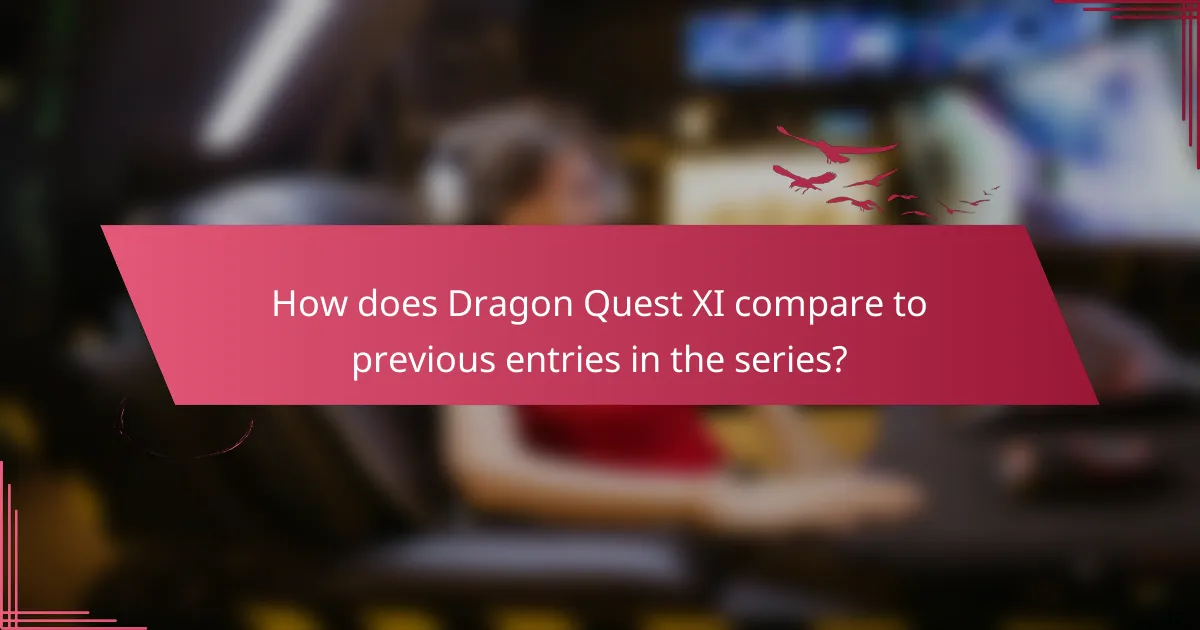Dragon Quest XI offers a compelling narrative that intertwines heroism, identity, and the struggle between good and evil. It features complex character arcs that evolve through personal growth and relationships. The game reflects cultural influences from Japanese storytelling, emphasizing themes of honour and community. Additionally, it explores the tension between fate and free will, challenging characters to shape their destinies.

What are the core narrative themes in Dragon Quest XI?
Dragon Quest XI explores themes of heroism, identity, and the struggle between good and evil. The narrative depth is enriched by character arcs that evolve through personal growth and relationships. Cultural influences reflect traditional Japanese storytelling, emphasizing honour, sacrifice, and the importance of community. The game also addresses the concept of fate versus free will, challenging characters to forge their paths despite predetermined destinies.
How does the story structure enhance player engagement?
The story structure in Dragon Quest XI enhances player engagement by intertwining character arcs with a rich narrative. This approach fosters emotional investment, as players connect with characters’ journeys. The game’s pacing balances exploration and storytelling, maintaining interest. Cultural influences embedded in the narrative deepen the experience, offering players a sense of immersion and relatability. Overall, this structure creates a compelling framework that captivates players throughout their adventure.
What role does the hero’s journey play in the plot?
The hero’s journey is central to Dragon Quest XI’s plot, driving character development and thematic depth. This narrative structure follows the protagonist, who embarks on a transformative adventure filled with trials and growth. Key stages include the call to adventure, facing challenges, and achieving personal growth, which resonate with players.
The journey emphasizes themes of friendship, courage, and sacrifice, reflecting cultural influences from classic hero tales. Characters undergo significant arcs, evolving through their experiences, which enhances emotional engagement. This alignment with the hero’s journey enriches the story, making it relatable and impactful for players.

Who are the main characters, and what are their arcs?
The main characters of Dragon Quest XI include the Luminary, Erik, and Jade, each with distinct arcs. The Luminary embarks on a quest to reclaim his destiny and unite allies against darkness. Erik evolves from a thief seeking personal gain to a loyal friend committed to the greater good. Jade transforms from a fierce warrior to a compassionate leader, embracing her heritage and responsibilities. These arcs reflect themes of friendship, identity, and redemption, enriching the narrative’s depth.
How do character relationships evolve throughout the game?
Character relationships in Dragon Quest XI evolve significantly, reflecting personal growth and narrative depth. Initially, characters may have superficial interactions, but as the story progresses, their bonds deepen through shared experiences and challenges. This transformation is pivotal to the game’s emotional impact.
Key moments, such as pivotal battles or personal trials, serve to strengthen connections among characters. For example, the protagonist’s journey fosters camaraderie, revealing unique attributes of each character, such as resilience and loyalty. As a result, players witness a rich tapestry of evolving dynamics that enhance the overall narrative experience.
The game also incorporates cultural influences that shape these relationships, adding layers of complexity. Characters embody traits that resonate with traditional values, such as honour and friendship, which further enrich their interactions. Through these evolving relationships, players engage with a story that emphasizes growth, unity, and the power of companionship.
Which characters have the most significant transformations?
The characters with the most significant transformations in Dragon Quest XI are the Luminary, Erik, and Jade. The Luminary evolves from a reluctant hero to a powerful saviour, showcasing growth through adversity. Erik transitions from a thief to a loyal ally, revealing depth and honour. Jade, initially perceived as a warrior, unveils her compassionate side and leadership qualities. These transformations highlight the narrative’s emphasis on personal growth and resilience.

What cultural influences are reflected in Dragon Quest XI?
Dragon Quest XI reflects various cultural influences, including Japanese folklore, mythology, and societal values. The game incorporates familiar themes such as heroism, camaraderie, and the struggle between good and evil. Characters often embody archetypal roles found in traditional narratives, enhancing relatability. Additionally, the art style and world design draw inspiration from Japanese aesthetics, emphasizing nature and harmony. The narrative’s depth showcases cultural nuances, making it a rich tapestry of influences that resonate with players globally.
How does Japanese culture shape the game’s world-building?
Japanese culture significantly influences the world-building in Dragon Quest XI through its rich folklore, aesthetics, and societal values. The game incorporates traditional Japanese storytelling techniques, emphasizing heroism, honour, and the journey of self-discovery. Cultural elements, such as Shinto beliefs and the concept of nature’s spirit, manifest in the game’s landscapes and character designs. The vibrant art style reflects Japanese anime influences, enhancing the immersive experience. Additionally, the game’s themes of friendship and perseverance resonate with core Japanese values, creating a relatable narrative for players.
What elements of Western storytelling are integrated into the narrative?
Dragon Quest XI integrates elements of Western storytelling through character development, thematic depth, and narrative structure. The characters experience significant growth, mirroring the hero’s journey common in Western tales. Themes of friendship, sacrifice, and the battle between good and evil resonate throughout the narrative, reinforcing universal storytelling principles. Additionally, the use of a linear plot progression, combined with character arcs, aligns with traditional Western storytelling techniques, providing a familiar framework for players.

How does the game address themes of friendship and sacrifice?
Dragon Quest XI explores themes of friendship and sacrifice through character relationships and pivotal narrative moments. The protagonist and companions face challenges that test their bonds, highlighting loyalty and selflessness. Key sacrifices made by characters deepen emotional connections and drive the story forward, reinforcing the importance of unity in overcoming adversity. These themes resonate with players, making the narrative impactful and relatable.
What moments highlight the importance of teamwork?
Teamwork is crucial in Dragon Quest XI, highlighted through character interactions and shared goals. Key moments include the formation of the party, where diverse abilities combine to overcome challenges. For example, Erik’s agility complements the hero’s strength, showcasing how teamwork enhances individual strengths. Additionally, emotional scenes, such as supporting each other during personal struggles, emphasize the bond formed through collaboration. These moments reinforce the narrative’s depth, illustrating that success relies on unity and mutual support.
How are sacrifices portrayed in character development?
Sacrifices in Dragon Quest XI significantly enhance character development by showcasing personal growth and moral dilemmas. Characters face choices that reveal their values, motivations, and relationships. For example, the protagonist’s journey involves selflessness, illustrating a unique attribute of heroism through sacrifice. This narrative depth creates emotional resonance, allowing players to connect with characters on a profound level. As a result, sacrifices become pivotal moments that define character arcs and influence the overall story.

What unique gameplay mechanics support the narrative?
Unique gameplay mechanics in Dragon Quest XI enhance its narrative by integrating character interactions and choices that influence the story’s progression. The game’s turn-based combat system includes unique abilities tied to character arcs, allowing players to experience personal growth through battles. Additionally, the use of “Luminary” powers connects gameplay mechanics with the narrative’s themes of destiny and self-discovery. Side quests further enrich the story, revealing cultural influences and character backstories, creating a deeper emotional investment in the narrative. These mechanics collectively support the overarching themes of heroism and camaraderie within the game’s world.
How does the turn-based combat system enhance storytelling?
The turn-based combat system in Dragon Quest XI enhances storytelling by allowing players to engage deeply with character development and plot progression. Each battle serves as a narrative device, showcasing character growth through unique abilities and interactions. The strategic nature of combat creates tension and emotional investment, making victories feel meaningful. Additionally, the pacing of turn-based mechanics aligns with the game’s storytelling rhythm, giving players time to absorb the narrative and character arcs. This integration fosters a richer gaming experience, where gameplay and story are interwoven seamlessly.
What role do side quests play in character development?
Side quests significantly enhance character development in Dragon Quest XI. They provide opportunities for deeper backstories and personal growth. Engaging in these quests allows players to explore unique attributes of characters, revealing their motivations and relationships. This narrative depth enriches the overall experience, making characters more relatable and memorable. Additionally, side quests often reflect cultural influences, showcasing diverse themes and values that resonate with players.

How does Dragon Quest XI compare to previous entries in the series?
Dragon Quest XI offers richer narrative depth, complex character arcs, and diverse cultural influences compared to previous entries. The game features a more cohesive story that intertwines character development with thematic elements, enhancing emotional engagement.
Character arcs in Dragon Quest XI are more nuanced, showcasing growth and transformation through personal challenges. This is a unique attribute, distinguishing it from earlier titles where character development was often less prominent.
Culturally, Dragon Quest XI integrates various influences, reflecting a broader scope of storytelling. This rare attribute enriches the game’s world, making it resonate with a wider audience.
Overall, Dragon Quest XI stands out for its sophisticated narrative structure and character exploration, setting a new benchmark in the series.
What are the narrative advancements made in this installment?
Dragon Quest XI introduces significant narrative advancements through deep character arcs and cultural influences. The game explores themes of identity, sacrifice, and destiny, enriching the storyline. Character development is notable, particularly in the protagonist’s journey, which emphasizes personal growth and emotional connections. Additionally, the narrative incorporates diverse cultural elements, enhancing its depth and relatability. Overall, these advancements contribute to a more immersive and engaging experience for players.
How do character designs reflect changes in cultural trends?
Character designs in Dragon Quest XI reflect cultural trends through their evolution and diversity. The game’s characters embody values such as heroism and resilience, mirroring contemporary societal ideals. Unique attributes in design, like gender representation and emotional depth, showcase shifts towards inclusivity. As a result, these designs resonate with players, illustrating broader cultural narratives. Additionally, character arcs align with changing perceptions of morality and personal growth, enhancing the game’s narrative depth.

What critical reception did the narrative and character arcs receive?
Dragon Quest XI received widespread acclaim for its narrative depth and character arcs. Critics praised the game’s ability to blend traditional storytelling with modern themes, creating a rich emotional experience. The protagonist’s journey and the development of supporting characters resonated with players, showcasing unique attributes that enhanced the overall narrative. The game’s cultural influences, drawn from Japanese RPG traditions, contributed to its positive reception, highlighting a rare blend of nostalgia and innovation.
How do players perceive the emotional depth of the story?
Players perceive the emotional depth of Dragon Quest XI as profound and engaging. The narrative intricately weaves character arcs that resonate with players, showcasing personal growth and relationships. This emotional connection is enhanced by cultural influences, which enrich the story’s themes of heroism and sacrifice. Players often cite the game’s ability to evoke genuine feelings, making the overall experience memorable and impactful. The unique character development, particularly of the protagonist, further amplifies this emotional engagement, allowing players to empathise deeply with their journey.
What critiques have been made regarding character development?
Critiques of character development in Dragon Quest XI highlight a perceived lack of depth and complexity. Some players feel that character arcs follow predictable patterns and do not evolve significantly throughout the narrative. Additionally, certain characters appear to serve primarily as archetypes rather than fully realised individuals. Critics argue that this limits emotional engagement and reduces the impact of character-driven moments. The reliance on traditional tropes may also detract from the innovative storytelling expected in modern RPGs.
What expert insights can enhance the understanding of the narrative?
Expert insights reveal that Dragon Quest XI excels in narrative depth through its rich character arcs and cultural influences. The game weaves personal growth with broader themes, enhancing player engagement. Characters like the Luminary evolve, reflecting universal struggles. Cultural elements, such as Japanese folklore, enrich the storyline, providing a unique backdrop. The interplay of these attributes fosters a compelling narrative experience that resonates across diverse audiences.
What are common mistakes to avoid when interpreting the story?
Common mistakes when interpreting the story of Dragon Quest XI include overlooking character development, misreading cultural influences, and ignoring narrative structure. Failing to recognize the significance of character arcs can lead to a shallow understanding of the plot. Cultural references enrich the narrative; disregarding them can obscure deeper meanings. Lastly, neglecting the narrative’s pacing and transitions may result in confusion about plot progression.


